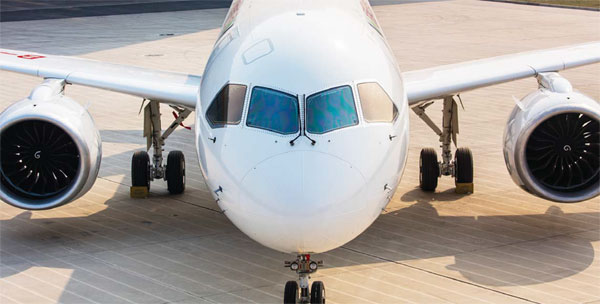Silence is golden for the commercial aircraft
By Zhu Wenqian (China Daily Europe) Updated: 2017-02-12 13:29Aircraft noise can make passengers feel irritable. The sound of planes taking off and landing has a major impact on airports and the people who live near them. The noise level of an aircraft has important bearings on its comfort, environmental impact and market competitiveness.
Xu Kangle, a researcher at Shanghai Aircraft Design and Research Institute, the research center for the Commercial Aircraft Corp of China, has been working hard to tackle the problem of aircraft noise.
Xu majored in noise engineering and has been focused on keeping noise levels as low as possible for the C919 aircraft.
Becoming a noise engineer requires strong mathematics and physics skills, as well as specialized knowledge.
|
The C919 is said to have high aerodynamic efficiency, low operation and maintenance costs, low fuel consumption and low engine noise. |
"The first task that I did was write code for the related programs of the external noise of aircraft. I came across some difficulties and I read a lot of technical documents and literature. I learned from overseas experts and solved the problems," he says.
Research, development and the manufacture of the C919 involves the hard work of many staff, including Ma Sai, chief inspector for production at Shanghai Aircraft Manufacturing Co Ltd, the assembly center for COMAC.
Born in the 1960s, he has been working at the manufacturing site for more than 30 years. The thing he feels most uncomfortable with is sitting in his office. He prefers to be on site, helping to solve problems.
"I think the key to solving problems is that the director has to be at the site every day. Only that way can we help deal with issues and ensure production tasks are finished in accordance with the plan," Ma says.
For the C919, 85 percent of the tail is made from composite materials. The technology of applying composite materials is still in its infancy in China and requires mould manufacturing, temperature control and other techniques.
Every day, Ma handled various problems and made progress reports to ensure production proceeded smoothly. Eventually, Ma and his team finished production and delivery of 731 components.
"Most staff at our center are young. I think the future of the company is very promising. The manufacture of other new aircraft will be completed by them and I hope they can master the techniques soon," Ma says.
"As for myself, I wish to join the manufacturing projects for a wide-bodied aircraft before I retire. I would be very satisfied if I was able to participate in three commercial aircraft projects in my life," he says.
A wide-bodied commercial jet being developed by China and Russia is expected to be delivered in 10 years, as early as three years after its first test flight, according to a timetable announced by COMAC last year.
COMAC and Russia's United Aircraft Corp have set up a Shanghai-based joint venture to develop the jumbo jet. Research and development will be conducted in Moscow, with assembly in Shanghai.
zhuwenqian@chinadaily.com.cn
Milestone of the C919
May 11, 2008: The Commercial Aircraft Corp of China (COMAC) was officially established in Shanghai.
Jan 6, 2009: COMAC unveiled the code of its first 150-seat single-aisle passenger aircraft as COMAC919, abbreviated as C919.
Dec 21, 2009: COMAC and CFM International signed the letter of intent to use the CFM LEAP-1C engine as the sole foreign starting power device for the C919.
Nov 15, 2010: The display model of C919 in its real size was demonstrated at the Zhuhai Airshow for the first time, and COMAC netted 100 orders.
Dec 30, 2013: The C919 aircraft project successfully completed flight control hydraulic system tests. It took four years to build up the test bench for the "Iron Bird" as the C919 is often called, and the "Iron Bird" was officially put into use.
Nov 2, 2015: The first C919 large passenger aircraft rolled off the assembly line.
Dec 25, 2016: The first aircraft of C919 was delivered to the flight test center.
- 'Cooperation is complementary'
- Worldwide manhunt nets 50th fugitive
- China-Japan meet seeks cooperation
- Agency ensuring natural gas supply
- Global manhunt sees China catch its 50th fugitive
- Call for 'Red Boat Spirit' a noble goal, official says
- China 'open to world' of foreign talent
- Free trade studies agreed on as Li meets with Canadian PM Trudeau
- Emojis on austerity rules from top anti-graft authority go viral
- Xi: All aboard internet express












